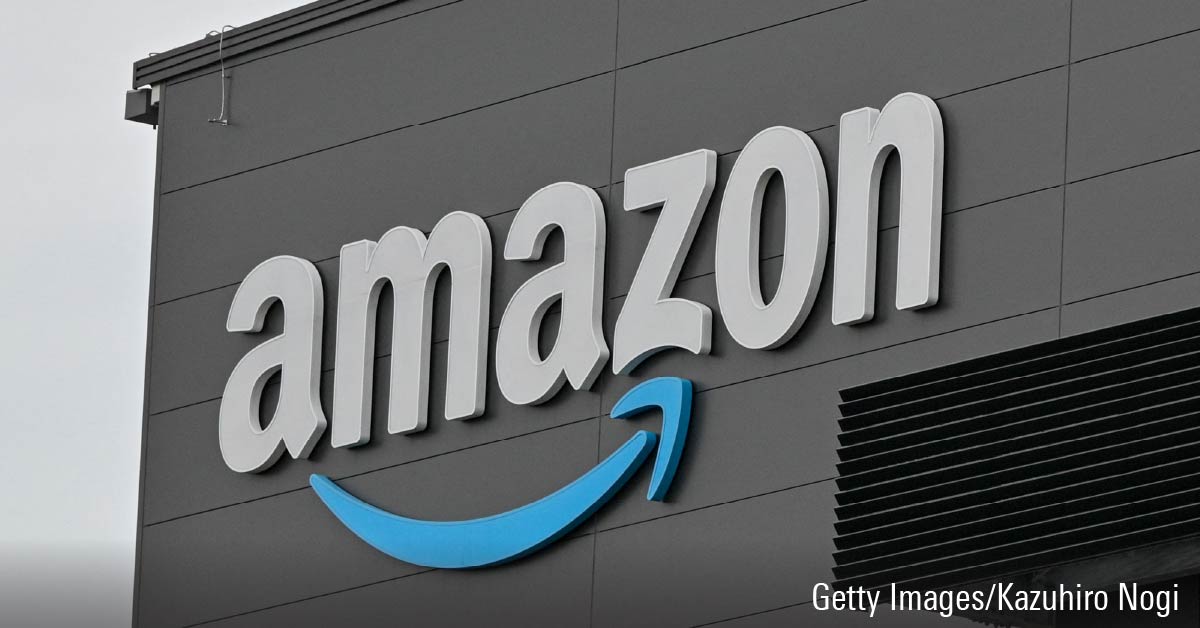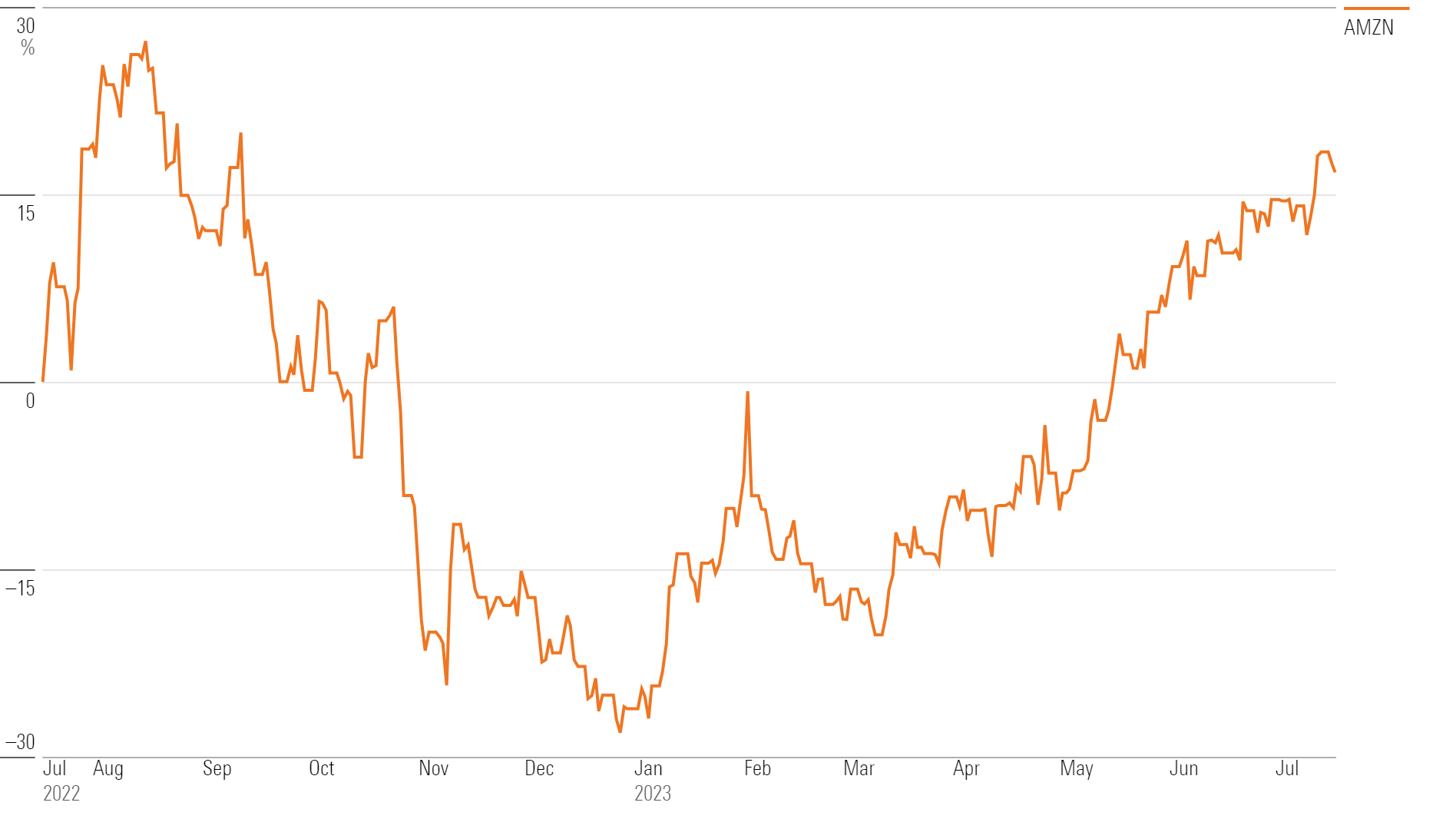Heading Into Earnings, Is Amazon Stock a Buy, Sell, or Fairly Valued?
Focusing on AWS growth trends, Google advertising, and overall profitability in Q2 earnings.

As Amazon.com AMZN gets ready to release its second-quarter results on Aug. 3, here’s Morningstar’s take on what to think of the company’s outlook and stock.
Key Morningstar Metrics for Amazon
- Fair Value Estimate: $137.00
- Morningstar Rating: 3 stars
- Morningstar Economic Moat Rating: Wide
- Morningstar Uncertainty Rating: High
What We’re Watching in Amazon’s Earnings
- Amazon Web Services growth and backlog. Growth has been decelerating meaningfully for the last several quarters, as customers are taking more time to make sure they are maximizing their contracts amid macroeconomic uncertainty.
- Guidance for Q2 AWS growth was certainly below expectations. AWS is one of two key growth drivers for the company, and as a result, this is a near-term headwind. We expect growth should re-accelerate within the next several quarters.
- Advertising trends. Advertising is Amazon’s other key growth driver. Both AWS and advertising are high-margin businesses. The firm’s advertising is slowing but seems to be holding up better than at Meta Platforms META or Alphabet GOOGL.
- E-commerce trends. We are looking for results that are in line with consensus expectations that they will improve.
- Profitability, especially given substantial layoffs over the last several quarters and strong results here last quarter.
Amazon.com Stock Price

Fair Value Estimate for Amazon Stock
With its 3-star rating, we believe Amazon’s stock is fairly valued compared with our long-term fair value estimate.
Our fair value estimate for Amazon is $137 per share, which implies a 2022 enterprise value to sales multiple of 3 times and a 1.7% free cash flow yield. We think multiples are a little less meaningful for Amazon, given the ongoing heavy investment and rapid scaling that depresses financial performance. However, we expect the company to significantly grow its free cash flow as it matures.
Over the long term, we expect e-commerce to continue to take share from brick-and-mortar retailers. We further expect Amazon to gain share online. We believe that over the medium term, the COVID-19 pandemic pulled forward some demand by changing consumer behavior and better penetrating some retail categories, such as groceries, pharmacy, and luxury goods, that previously had not gained as much traction online. We think Prime subscriptions and the accompanying benefits, combined with selection, price, and convenience, continue to drive the retail story. We also see international as a longer-term opportunity within retail.
Read more about Morningstar’s fair value estimate for Amazon stock.
Amazon.com Historical Price/Fair Value Ratios

Economic Moat Rating
We assign a wide moat rating to Amazon based on its network effects, cost advantages, intangible assets, and switching costs. Amazon has been disrupting the traditional retail industry for more than two decades while also emerging as the leading infrastructure-as-a-service provider via AWS.
This disruption has been embraced by consumers and driven change across the entire industry, as traditional retailers have invested heavily in technology to keep pace. COVID-19 has accelerated change, and given the company’s technological prowess, massive scale, and relationship with consumers, we think Amazon has widened its lead, which we believe will result in economic returns well in excess of its cost of capital for years to come.
Amazon’s retail business network effects stem from its marketplace, whereby more buyers and sellers continually attract additional buyers and sellers. It has a cost advantage tied to its purchasing power, logistics, vertical integration (proprietary brands, owned delivery, and so on), and a negative cash conversion cycle. Its intangible assets are associated with technology and branding.
We also believe AWS is a wide-moat business, thanks to high customer switching costs, a cost advantage associated with economies of scale (few competitors can keep up with Amazon’s investment pace), intangible assets arising from semiconductor and facility development, and a network effect associated with a marketplace for software created to make AWS work better.
We also would assign Amazon’s burgeoning advertising business a narrow moat, based on intangible assets from its proprietary data on hundreds of millions of users and a network effect focusing on buyers and sellers meeting in the largest available venues. We believe the wide moat for Amazon’s entire business is greater than the sum of its parts. We prefer to analyze Amazon’s moat on the whole, as the company’s segments reinforce one another and its returns, resulting in an unrivaled consumer experience.
Read more about Amazon’s moat rating.
Risk and Uncertainty
Despite being an e-commerce leader, Amazon faces a variety of risks. The firm must protect its leading online retail position, which can be challenging as consumer preferences change, especially as the status quo returns after the pandemic (as consumers may revert to prior behaviors) and traditional retailers bolster their online presence.
Maintaining an e-commerce edge has pushed the company to make investments in nontraditional areas, such as producing content for Prime Video and building out its own transportation network. Similarly, the company must maintain an attractive value proposition for its third-party sellers. Some of these investment areas have raised investor questions in the past, and we expect management to continue to invest according to its strategy, despite periodic margin pressure from increased spending.
The company must also continue to invest in new offerings. AWS, transportation, and physical stores (both Amazon-branded and Whole Foods) are three notable areas of investment. These decisions require capital allocation and management focus and may play out over a period of years rather than quarters.
Read more about Amazon’s risk and uncertainty.
AMZN Bulls Say
- Amazon is the clear leader in e-commerce and enjoys unrivaled scale to continue to invest in growth opportunities and drive the very best customer experience.
- High-margin advertising and AWS are growing faster than the corporate average, which should continue to boost profitability over the next several years.
- Amazon Prime memberships help attract and retain customers, who then spend more with Amazon. This reinforces a powerful network effect while bringing in recurring and high-margin revenue.
AMZN Bears Say
- Regulatory concerns are rising for large technology firms, including Amazon. Further, the firm may face increasing regulatory and compliance issues as it expands internationally.
- New investments—notably in fulfillment, delivery, and AWS—should dampen free cash flow growth. Also, Amazon’s penetration into some countries might be harder than in the United States due to inferior logistic networks.
- Amazon may not be as successful in penetrating new retail categories, such as luxury goods, due to consumer preferences and an improved e-commerce experience from larger retailers.
This article was compiled by Tom Lauricella.
The author or authors do not own shares in any securities mentioned in this article. Find out about Morningstar’s editorial policies.


/cloudfront-us-east-1.images.arcpublishing.com/morningstar/CFV2L6HSW5DHTFGCNEH2GCH42U.jpg)
/cloudfront-us-east-1.images.arcpublishing.com/morningstar/PDHJPZBNVRCAFEQ2AHYHABU2AU.png)
/cloudfront-us-east-1.images.arcpublishing.com/morningstar/54RIEB5NTVG73FNGCTH6TGQMWU.png)